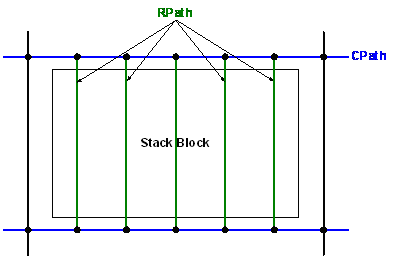
The yard path model enables you to define two block-level paths and multiple row-level paths for each stack block. Since the two block-level paths are parallel to the column access axis, they are called Column Paths or CPaths. And since the row-level paths are parallel to the row axis, they are called Row Paths, or RPaths.
The figure illustrates the definition of the CPaths and RPaths, which are independent of each other and can have different properties.
Yard Editor enables you to create the RPaths automatically for all rows in a stack block (see Create row vertices and paths (on page 1)).
Figure: CPath and RPath definitions

In N4, a path is defined by a traffic line and is bound by an ingress point and an egress point. The ingress and egress points can be two different vertices or a single vertex.
The following table describes the valid paths that the stack block model supports, where I = ingress point and E = egress point.
Table: Valid paths supported by the stack block model
|
Case |
Path |
Vertices |
Traffic Flow |
|---|---|---|---|
|
1* |
|
2 vertices I = low; E = high |
Undefined |
|
2* |
|
2 vertices I = high; E = low |
Undefined |
|
3 |
|
1 vertex I, E = low |
Undefined |
|
4 |
|
1 vertex I, E = high |
Undefined |
|
5 |
|
2 vertices I = low; E = high |
Ascending |
|
6 |
|
2 vertices I = high; E = low |
Descending |
|
7 |
|
1 vertex I, E = low |
Two way |
|
8 |
|
1 vertex I, E = high |
Two way |
|
9 |
|
2 vertices I, E = low; I, E = high |
Two way |
* N4 treats cases 1 and 2 as equivalent cases, where each has 2 different vertices, one at low and one at high.